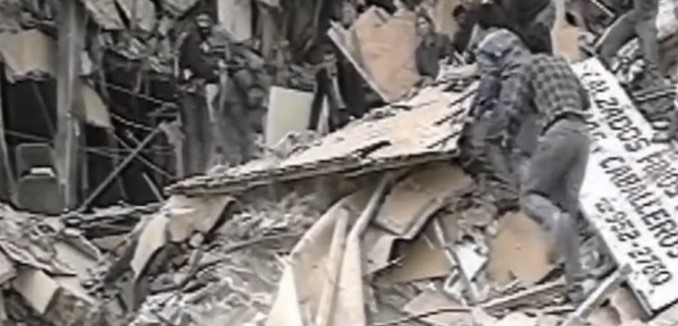This week is the twenty-fourth anniversary of the bombing of the Israeli-Argentine Mutual Association (AMIA) Jewish community center in Buenos Aires, one of the worst terrorist acts against Jews since World War II.
On the morning of July 18, 1994, Ibrahim Hussein Berro, a Lebanese citizen, drove a Renault Trafic van loaded with 300 kilograms of explosives into the Buenos Aires Jewish community center. The van detonated at the entrance of the AMIA, resulting in the death of 85 people and wounding hundreds. Hussein Berro was a member of Iran’s terror proxy, Hezbollah.
The attack brought Iran and Hezbollah to the international forefront, and despite public attention, both continued to develop intelligence and logistical networks throughout Latin America, a practice that had been ongoing since the 1980s. But this was not the first time Iran and Hezbollah had performed a terror act in South America—only two years prior, a Ford F-100 panel van detonated in front of the Israeli Embassy in Buenos Aires.
In a democracy with strong and transparent institutions, the investigation of the deadliest terror attack in the country would not have taken twenty-four years. But the original judicial probe was mishandled, poorly executed, and stalled for years. It wasn’t until an investigation by Argentina’s Intelligence Secretariat in 2002 and later by prosecutor Alberto Nisman that confirmed the identity of the driver.
The judge handling the case was removed from it in 2003 due to serious irregularities and former Argentine president Carlos Menem, under whose presidency the attack happened, was charged with ordering the judge to drop the Syrian connection of the attack. It has been reported that Menem tried to protect a Syrian family friend (Menem is of Syrian descent). The inability to bring justice to the victims, survivors, and families was nothing short of frustrating and embarrassing. It appears that Iran targeted Argentina, in part, because there was little accountability there, making it more likely that the attack could be perpetrated with impunity.
After almost a decade of incompetence, special prosecutors Marcelo Burgos (who later left his office) and Alberto Nisman began their investigation. Nisman concluded that Iranian and Hezbollah officials planned the attack, and that former Iranian president Ali Akbar Rafsanjani, along with other high ranking Iranian government officials gave the final approval at a meeting in Mashhad, Iran in August of 1993. Nisman’s investigations prompted Interpol to issue red notices (similar to international arrest warrants) to several key Iranian officials, but Iran ignored them.
When Cristina Fernandez de Kirchner became the Argentine president, the AMIA investigation took a bizarre turn, and by 2013, Buenos Aires and Tehran had signed a memorandum of understanding and created a so-called joint “truth commission” to investigate the 1994 bombing together. Having the chief suspects in the terror attack investigating themselves was absurd and the memorandum of understanding was dropped when Mauricio Macri became president in 2015.
Nisman charged that Kirchner and Hector Timerman, the former Argentine Foreign Minister, played a critical role in covering up Tehran’s role in the AMIA bombing. In January 2015, Nisman was found dead the day before he was due to testify before Congress of his findings. While a federal court subsequently concluded that he was murdered, much about the case remains a mystery.
The AMIA investigation has been nothing short of a disaster, and as the investigation stalled, Hezbollah and Iran continued to build a more robust intelligence and operation network in the region. Following the attack in 1994, the U.S. State Department’s coordinator for counterterrorism highlighted that Iranian embassies’ staff in Latin America had increased. There was a fear that some of these diplomats had terror links or were intelligence agents. Throughout his career, Nisman warned of Iran’s and Hezbollah’s expansive operations in the region and in 2013, Nisman’s 500-page report warned of clandestine intelligence stations in Latin America.
Additionally, the U.S. State Department’s annual Country Reports on Terrorism for 2015 highlighted that Hezbollah “continued to maintain a presence in the region, with members, facilitators and supporters engaging in activity in support of the organization,” trying to expand its “infrastructure in South America and fundraising, both through licit and illicit means.” Hezbollah strategically established itself in America’s backyard, posing an ongoing security threat to the region and the United States.
The AMIA investigation had no serious repercussions until recently: Kirchner will be tried for covering up Iran’s role in the attack. Timerman was placed on house arrest (later released on humanitarian grounds) and will go on trial as well. Several confidantes of Kirchner’s administration are also expected to be charged in the cover-up.
Earlier this month, an Argentine federal judge investigating the case requested Russia and China to arrest and extradite former Iranian Foreign Minister Ali Akbar Velayati, who along with other high ranking Iranian officials, is accused of ordering the attack. A few days later, the Argentine Financial Information Unit froze the assets of a suspected Hezbollah fundraising network in the Triple Frontier — also known as the Tri-Border area — which is where the AMIA attack originated.
Twenty-four years of corruption and impunity have allowed Iran and Hezbollah to expand its logistics, financing and planning efforts in the region, posing a security threat to Latin America and the U.S.
For the victims and families, twenty-four years without justice is far too long. For others, twenty-four years without justice exposes them to a growing threat.
[Photo: History Bites / Facebook ]




